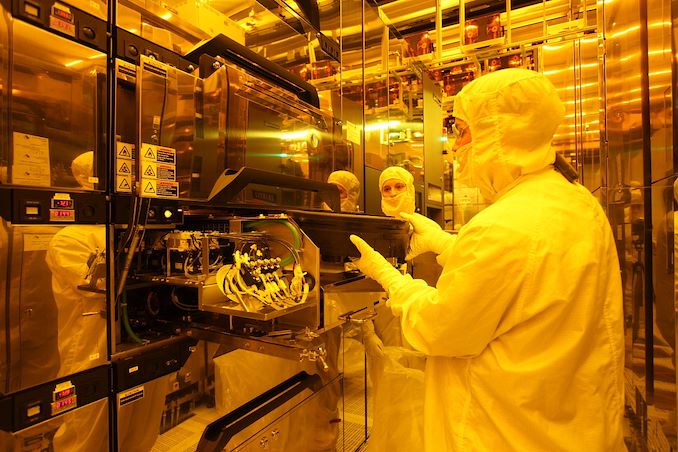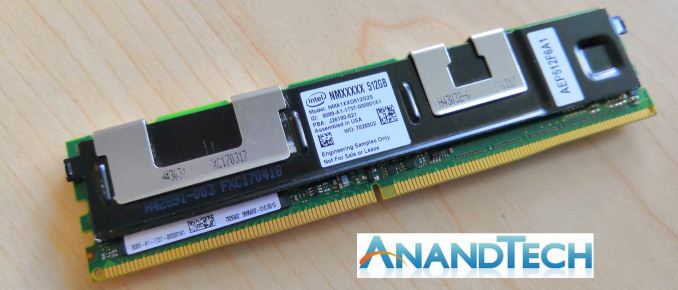Intel & Micron Sign New 3D XPoint Wafer Supply Agreement
by Anton Shilov on March 16, 2020 4:15 PM EST
Intel and Micron have inked a new 3D XPoint memory wafer supply agreement. Analysts believe that Intel will now have to pay Micron more than it did previously as it is now the only maker of 3D XPoint. The new pact also shows that Intel wants to continue making products based on 3D XPoint, but details about the products remain to be seen.
Having ended its NAND and 3D XPoint partnerships with Micron, Intel sold its former partner its stake in their mutually owned fab in Lehi, Utah. Since the company yet has to move production of 3D XPoint memory used for its Optane-branded products to its Fab 68 in Dalian, China, the chipmaker had to sign a supply agreement with Micron, under which the latter would sell the memory to its former ally at pre-agreed prices for one year after it gains ownership of the fab.
Micron gained ownership back in October, which is when the agreement came into effect. As it turns out, the two companies terminated the deal on March 9 and signed a new one ‘with changes to pricing and forecast terms’. The companies did not reveal additional details, but Micron said that the deal was ‘not material to Micron and does not change Micron’s previously-communicated outlook’.
Meanwhile, market analysts believe that Intel loses rather massive amounts of money on its 3D XPoint products despite their premium pricing.
Jim Handy, an analyst with Objective Analysis, told Blocks & Files the following:
“Intel is losing money in its NVM Solutions Group (NSG) because 3D XPoint is proving very unprofitable to produce. By my estimate Intel lost about $2 billion on 3D XPoint in each of 2017 and 2018, and $1.5 billion in 2019.”
Perhaps, indirectly, not very favorable costs of 3D XPoint are confirmed by Micron’s reluctance to build products on their base. So far, Micron has announced only one SSD series featuring 3D XPoint memory, the X100. The new deal indicates that Intel has plans to proceed with its 3D XPoint-based Optane family of products, which play an important role to its datacenter business. Unfortunately, it is unclear from the announcement how Intel plans to develop its 3D XPoint lineup going forward.
The official statement from Intel and Micron reads as follows:
On March 9, 2020, Micron Technology, Inc. (“Micron”) and Intel Corporation (“Intel”) agreed to terminate, effective March 6, 2020, the Product Supply Agreement, dated April 6, 2012, among Micron, Intel, and Micron Semiconductor Asia Pte. Ltd. (the “PSA”). The PSA set forth the terms under which Micron agreed to supply 3D XPoint wafers to Intel at prices determined under a defined formula and in accordance with a negotiated forecast. Contemporaneous with the PSA’s termination, Micron and Intel entered into a new 3D XPoint wafer supply agreement with changes to pricing and forecast terms. The new agreement is not material to Micron and does not change Micron’s previously-communicated outlook that underutilization charges associated with Micron’s Lehi, Utah fab will average approximately $150 million on a quarterly basis in fiscal year 2020.
Related Reading
- Intel Memory Plans: No New NAND Capacity, Wants to Move 3D XPoint Production to China
- Micron to Pay Intel $1.3B to $1.5B for IM Flash Stake
- Intel And Micron To Discontinue Flash Memory Partnership
- Micron Finally Announces A 3D XPoint Product: Micron X100 NVMe SSD
Sources: Micron, Blocks & Files











20 Comments
View All Comments
ikjadoon - Monday, March 16, 2020 - link
It's the same every year: until Optane finds a *large* addressable market, it'll have low-volume, high-premium pricing. Enterprise & datacenter niches (a niche within a niche!) aren't 'large' enough in the world of NAND.Consumer software has clearly not caught up for anything useful at high QD1. Nada. Zero. Nothing. Useless. Don't even bring bloated vaporware, i.e., Star Citizen.
The only options I see for Optane to grow are because of its insanely good endurance and nothing about QD1:
1. High-end storage for videographers. RED sells 2013-era MLC-based RED SSDs that crap out quite often due to their relatively low endurance & massive write demands.
https://twitter.com/mkbhd/status/12268971083069235...
https://www.cinema5d.com/whats-inside-a-red-mini-m...
RED SSDs retail $2400 for 960GB, while inside it's stuffed with off-the-shelf ancient Crucial m500 drives. At that price point ($2.50/GB), Optane looks like a goddamned bargain.
2. "Small" embedded storage solutions for handheld game-consoles: not because of QD1, but Optane rules the read/write roost at 16 GB / 32 GB. At 64 GB, traditional NAND parallelization becomes more viable.
3. Ultra-high-end SD/microSD cards (if 3D-XPoint can be miniaturized and made efficient): some photographers will buy it. Again, not related to QD1 whatsoever, but the incredibly high endurance + the excellent read/write speeds at low capacity sizes.
The whole H10 debacle has only made Optane look worse, by pairing it in a crazy RAID with QLC. These things only sell because 1) they're the default config, 2) they're deceiving because you can say it's got an "Optane" SSD, when it's really 99% QLC and 1% Optane, and 3) H10 is probably cheaper to OEM/ODMs than a proper high-end SSD.
ikjadoon - Monday, March 16, 2020 - link
Phones, while enticing, don't fit the Optane game—but maybe some "Gaming RGB 7" Monstrosity" could sell it.Nobody wants a 16 GB / 32GB phone anymore. At 64 GB, NAND is already fast enough that nobody will notice the difference.
The *only* future on an Optane-based phone w/ large market share seems like...computational photography? But it's only going to be a somewhat larger buffer: RAM is already commonplace at 6 GB (sans iPhones) with high-end phones (the ones that could sustain a somewhat pricier Optane drive) already at 10 GB to 16 GB of RAM.
I do hope Optane sticks around long enough to be worth the investment. Z-NAND seems like a small evolution of SLC...
PaulHoule - Tuesday, March 17, 2020 - link
It would be interesting to see a platform (possibly phonish) that is "all optane", that is, has no separate RAM and SSD. It would need a lot of cache, maybe even eDRAM or a small stack of HBM. It would "boot" instantly, quickly go to a no-power sleep mode, etc.As for H10, it also seems to me that Optane would be an ideal solution for some of the conundrums around SSD design. SSDs need some place to store data structures (mapping tables) and also content that hasn't been committed to the SSD. Optane might be a better choice than DRAM for this role, it would save the need for capacitors to protect the temporary storage.
Of course storage vendors don't care if consumers lose their data because they know consumers will just blame Microsoft for everything.
Veedrac - Monday, March 16, 2020 - link
Optane has a really simple win condition with their DIMMs: beat RAM. If with next gen's doubling of layers and later further process refinement they figure out a way to sell a 64 GB DIMM for a bit over $100, and then they support it across most of their product line, it will make a lot of sense for a lot of people.name99 - Monday, March 16, 2020 - link
You make money through a profit coming or a profit going --- charge for the razor blades OR the razor handle, but not BOTH.Or to quote another wall street saying "Bulls make money, bears money, pigs get slaughtered"
Intel decided to charge a lot for both the Optane DIMMs AND the few specific Xeons that support them. And then is amazed that this shrinks the market to almost nothing!
If they'd had the brains to put Optane support on every CPU they ship, they'd be able to start growing the market as at least a few people would try installing maybe one Optane DIMM, just to see if that helped drastically speed up compile times or some other task.
vFunct - Tuesday, March 17, 2020 - link
Databases are the ideal application for Optane. They need fast random access and persistence. Optane crushes everything else for databases.FunBunny2 - Tuesday, March 17, 2020 - link
dang it. I thought I alone had figured that out! may be we can get a multi-million consultancy with Oracle?vFunct - Tuesday, March 17, 2020 - link
Kinda surprised that people haven't figured out that Optane's strength is bit-level random-accesses - not even block level.The people suggesting this would be good for gaming or media streaming have no idea what random access really is.
Databases are it for Optane, There isnt anything else for Optane.
FunBunny2 - Thursday, March 19, 2020 - link
"Optane's strength is bit-level random-accesses - not even block level."but... and it's a big butt, OS support for direct memory-to-memory processing, bypassing all those registers/caches/buffers is needed. not to mention an ISA that is based on that notion. there have been such cpu, more or less, in the past. but load/store of RISCy designs have been held sway for nearly a couple of decades. processor/OS protocol of block I/O has to go. gonna take some engineers with mighty big gonads to pull that off.
Joe.Blobers - Tuesday, March 17, 2020 - link
Your comment about SSD tech make sense. However keep away your remark about Star Citizen.Best 45$ I ever spend on any game, released or crowdfunded.
+1.2 million individual bacekrs (not registred account which is double that number) do enjoy current Alpha (yes with bugs and crash).
Have a good day.